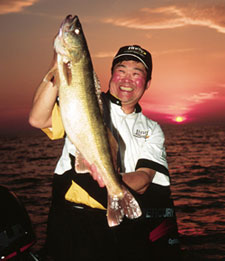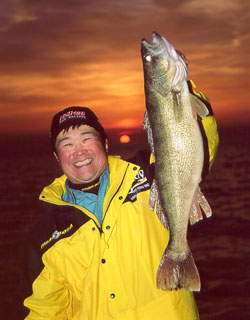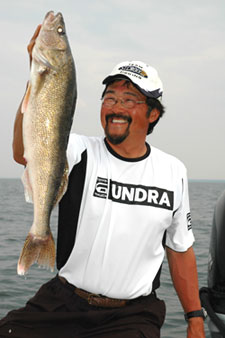 Working the night shift can help you land the walleye of your dreams.
Working the night shift can help you land the walleye of your dreams.
But top walleye guide Greg Bohn sees this scene all the time– taillights at the boat ramp, indicating all the other anglers are headed home, just as the prime time for big walleyes is about to begin.
“Lakes go from very busy, with lots of activity, to boats getting pulled out of the water, just when I’m just getting ready to fish,” said Bohn, of Minocqua, Wisconsin. “Many anglers know there’s a good bite nearing dark. But they leave too soon. The walleyes are just starting to move.
“They’re really missing the boat by not staying a little bit longer.”
Fishing at night requires a few added safety precautions. But, the overtime and care can pay big dividends. You can experience big numbers of fish, or target trophies.
“The action can be explosive when you find a spot where they are coming up to feed,” Bohn said. “You can have three lighted slip-bobbers going in three different directions at once. It’s not like one here or there unless you’re trying deeper water.
“The deeper the water, the bigger the fish, but you do have less action. You may not get anything at a spot one night and get two over 8 pounds the next night. That’s just how it goes.”
Night fishing with slip-bobbers works any time of year, but the optimum time is summer when the sun rises early and the morning feeding window is short-lived. Once sunlight intensifies, walleyes head to deeper water and bury themselves in the mud or weeds to wait for darkness when they can take advantage of their extraordinary low-light vision.
Summer is also the time when daytime boating activity is at a peak from skiers, other fishermen and personal watercraft. You may rush to the lake only to find a pontoon boat already anchored on your favorite fishing spot, and it may stay there all day.
“After dark, the lake is all yours,” says Bohn. The most productive nighttime lakes are often ones that don’t produce well during the day. “Some of our lakes don’t even wake up until sunset,” Bohn says.
Clear water is a common characteristic. Zebra mussels have made many lakes and reservoirs crystal clear. A lack of vegetation is another. Rusty crayfish have mowed thick weed beds down in many spots.
Wind is a friend. The worst nights follow afternoons when the breeze dies early and doesn’t return. When that happens, action tends to come in a surge, last a short time and stop.
“The wind is really important after dark. On nights when there’s a chop, the walleyes are more aggressive and the bite lasts for much longer,” Bohn said. “Walleyes are smart and cautious. Wind breaks up the water’s surface. Calm nights can be very touchy.”
Years of experience have also taught Bohn that moon phases play a role. “Three days before the full moon are awesome,” he said.
 Lights Out
Lights Out
Pinpointing spots to try after dark is no trick. Locations that produce during the day will produce at night. But, they may produce more walleyes or bigger ones with the lights out.
Bohn’s goal is to have two, three or four places fixed in his mind before he launches. Don’t wait until after nightfall to scout them. Visit during the day when obstructions, like buoys and rock humps close enough to the surface to damage lower units, are easily seen.
“You don’t want to be running around after dark to find places to fish,” Bohn said. If you have a GPS unit, mark key features on those scouting missions. For example, put a waypoint on the top of a submerged hump. Trace the breakline around a point, island or rock pile on the screen. Contact points where walleyes first arrive as they move from deep water to feed often become apparent.
Set more waypoints to find them easily later.
Do the same with weed beds. Submerged fields of vegetation can be massive. Trace the weedline looking for the points and turns where walleyes gather.
Take the guesswork out. Take time to pre-set the depth of floats. Bohn has noticed some important details concerning that topic.
“A weed bed in 10 feet of water may catch a lot of fish,” he says, “but the weed bed in 18 to 25 feet is where they’ll show up first.
They start at the fringes of the structure, but they’ll move shallower. When action slows, try the top of the structure of itself. When activity stops, think about moving, but check shallow water first.”
Thermocline also plays a key role. The best structures and features like weed beds will be the ones closest to where warm water meets cold.
“The thermocline has a lot to do with what structures are selected,” explains Bohn. “If the cold and warm water meet at 14 feet, then the bars at 12 to 14 feet are very, very important.”
The depth of the thermocline will change over time.
“That same thermocline in August may be at 24 feet. A lot of spots that produce in June and July will not produce later in summer,” he said. One other bit of information he’s collected can mean the difference between a livewell full of fish for the table or one trophy for the wall. Bohn said the places that yield lots of fish are rarely the same ones that deliver giants. Don’t be surprised if big-fish spots feature big boulders.
“Bobbers let you fish them,” he says, “where other techniques would not work.”
 The Modern Rig
The Modern Rig
Bohn, who wrote “Master the Art of Slip-Bobbering: the Deadliest Method for Walleye!” with outdoor writer Scott Richardson, has fine-tuned the slip-bobber rig to perfection over the years. More recently, he’s helped Lindy Fishing Tackle maintain its dominance of the slip-bobber market by helping design the Pro Series Thill Slip Bobber series.
The rig starts with a threaded bobber stop. Slide it on a main line of 10-pound Hi-Viz, yellow Power Pro, which is easily seen in the dark.
Floats in the Thill Nite Brite series are the right choices for slip-bobbers. They come in 4- or 5-inch models and with lights in three colors: red, yellow and green. Use at least two different colors, one for you and a different one for your partner. That helps quickly identify whose bobber is going under.
Bohn switches to the Thill Nite Brite Finesse float on really windy nights. The tall bobber is more visible in choppy water and supports a 1/16-ounce weight and sinker well. Unlike the center slider Nite Brites, the line slides through the X-Change line attachment at the bottom of the stem of the Finesse Float.
Lindy makes snell choice easy by selling fully-rigged snells tied with two colors of #4 Tru-Turn hooks (PS 401 is red and PS 402 is gold), and two colors of 1/16-ounce Bobber Bugs (PS 351 is firetiger and PS 352 is perch).
Bohn uses the shorter 4-inch center slide model of the Nite Brite float to support a hook and the longer 5-inch for the Bobber Bug.
Use rubber-core sinkers or soft split-shot to balance the rig.
As for bait, whole nightcrawlers attract big fish. “Panfish will bother them during the day, but they’re magic after dark,” Bohn said.
Some people hook the worm midway on the hook and let both sides dangle. Bohn prefers to slide the point in the nose, pull it back out and twist the hook before embedding it in the worm and pulling the nose up over the hook eye. He does a similar thing with Bobber Bugs. All that remains visible is the spinner and the head of the Bug.
Never leave the dock with only one kind of bait. Jumbo leeches are Bohn’s second choice. The reason: big bait, big fish. “If you’re going to the trouble to fish after dark, go for something nice,” he said.
Though Bohn recommends setting bait one foot off bottom during the day, he suggests trying different depths at night. Use leeches down low, but set worm rigs from a few feet down to several feet off the bottom.
“That is particularly true with suspended walleyes over sand bars and rock bars,” he says. “They are off the bottom sometimes 7 to 8 feet.”
The first couple of strikes will help you zero in on a productive depth for the night.
On the Water
Make like a Boy Scout and be prepared before heading out. Take lots of lights, including headlamps, lanterns and flashlights. A rechargeable spotlight is a great tool to get bearings while the boat is in motion and when landing fish.
Keep the floor of the boat clear. No tackle boxes should be left out to trip over. The net should be kept out of the way. Everyone should wear a life vest to keep the trip from turning into a nightmare. It’s just too easy to fall overboard.
Then, keep it simple. Head to spot number one, drop a marker buoy on the far side of the structure and anchor on the other side within casting distance. That way, the area is targeted. The fish should be somewhere in between.
Start fishing. Nothing? Try shallower or head to spot number two.
Action can be fast and furious. Or, there may be only one bite, but the head shakes throbbing through the rod could signal you’ve connected with the walleye of your dreams.










